Ferns are robust, and generally need little maintenance once established. Despite this resilience, new ferns are most vulnerable immediately after planting, and so it’s important to choose the best time of year to transfer them into the garden.
Ferns can be planted all year round, but the ideal time depends on the hardiness of the fern and your local climate. For frost-hardy ferns and regions with hot summers, the optimal time to plant out is the fall. For more cold-sensitive ferns or regions with hard winters, the best time to plant is spring. These schedules allow ferns to have several months to establish strong root systems before they have to face the most stressful local environmental conditions.
In addition to choosing the right time, there are some other factors that help ferns settle in quickly and give them the best chance of withstanding the worst of the weather. Getting the conditions right depends on the specific needs of the fern variety, and on preparing the ground well to give it the warmest welcome into your garden.
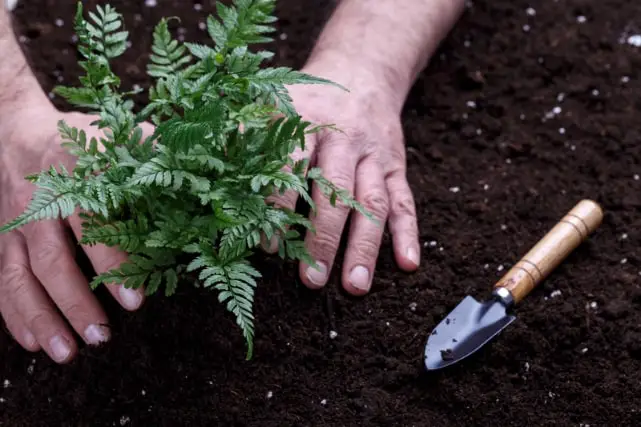
Check the needs of the fern
Ferns vary in their hardiness, and so step one is to check the match between the fern variety and the weather extremes expected for your region. The two key factors are the heat of summer, and the cold of winter. Review the hardiness zone of your region, against the hardiness rating of the fern. Similarly, some ferns are tolerant of sun and drought, whereas others are not, and need shade and plenty of water to survive.
Even if ferns are cold hardy as a species, young plants will be more vulnerable than older plants. When buying a new fern that is in its first year or two of growth, it is worth taking extra care to plant well before the first frosts arrive. For larger specimens, the timing can be more flexible as the fern will already have good energy stores and a more developed root network.
If you are keen to enjoy a fern that is not well suited to your local climate range, there is always the option to plant in a pot, and keep this on a deck or shaded corner of the garden when the weather is hospitable. The pots can then be moved into shelter when conditions become too taxing.
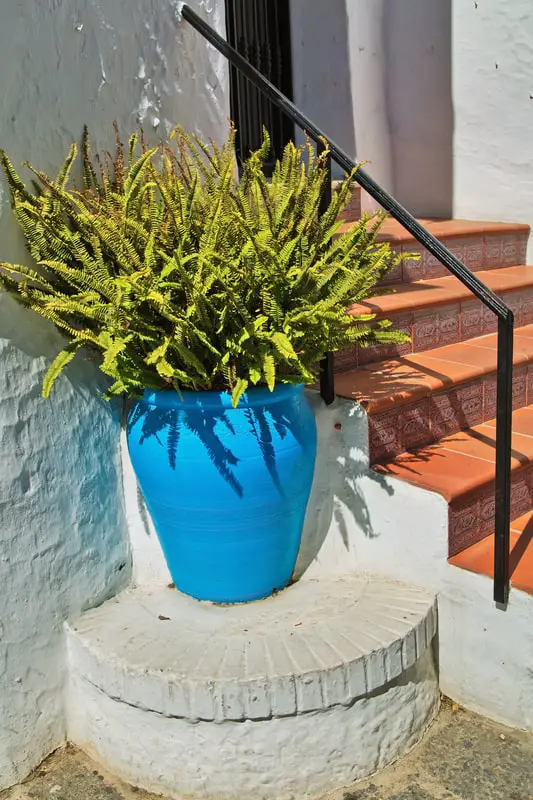
Prepare the ground well
The next way that you can help the fern to establish itself quickly is to prepare the soil well in advance. Most fern varieties like moist but well-drained soil, with a high organic content. That said, ferns are also generally pretty flexible, so if they don’t have the perfect conditions they can still thrive. Most soil types are tolerated, from clay to chalk, but you can help enrich with leaf mold or well rotted manure to give an early boost.
The other issue to keep in mind is watering and drainage. Some ferns tolerate waterlogged soil, but most prefer well-drained soil. Supplementing the soil with grit or coarse sand can help with this, to ensure that the roots do not stand in water soon after planting.
A final consideration is the acidity of the soil. Again, fern varieties vary in their preferences, but most are fine in neutral or mildly acidic soil. Some ferns – such as Hart’s tongue, Holly, and Maidenhair – favor alkaline conditions.
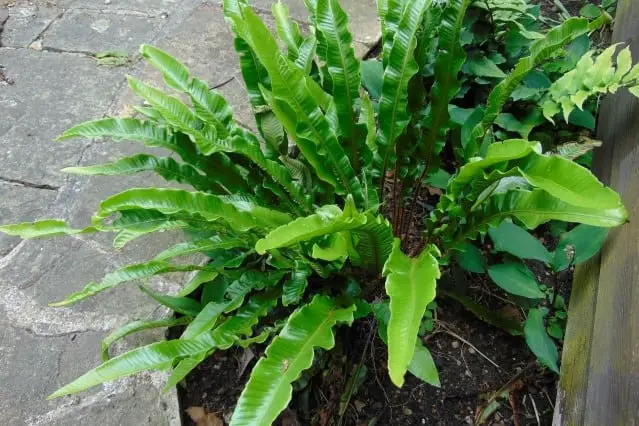
Hart’s tongue fern
- Asplenium scolopendrium
- Evergreen
- Prefers partial or full shade
- Height: up to 0.5 m
- Soil: alkaline or neutral. Moist, well drained.

Holly fern
- Cyrtomium falcatum
- Evergreen or semi-evergreen
- Full or partial shade
- Height: up to 1 m
- Soil: acid, neutral or alkaline. Moist, well-drained.
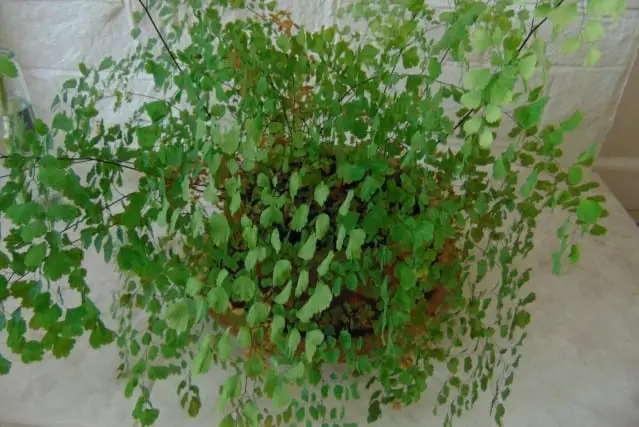
Maidenhair fern
- Adiantum raddianum
- Evergreen
- Partial shade
- Height: up to 0.5 m
- Soil: neutral or alkaline. Moist, well-drained.
There is not a lot that can be done to alter local soil conditions, beyond establishing containers with ericaceous or alicaceous soil, so the safer option is to match the fern to the soil. Happily, there is an abundance of choice for most conditions.
Don’t plant too deep
The next consideration is how deep to plant the fern. The roots of ferns are generally shallow, with rhizomes and crowns being close to the surface. The fiddleheads rise from the crown, and so it is important not to plant the fern too deeply, as this will suppress growth, and lead to the crown rotting and the fern dying.
The rule of thumb is to ensure that the fern is not planted any deeper in the new hole than it is in the original pot. You want the crown to sit at the same level after transplanting as it did when the fern established itself in the pot.
Another consideration is that the roots often do best in looser soil, almost as though the fern is perching proud on the surface of the soil. That means that after planting it is not necessary to stamp the fern into place. Simply fill the area around the crown with soil, and gently press the plant into the soil to prevent any air pockets being trapped around the roots.
That approach is sufficient to give the fern plenty of purchase, without risking damage to the roots or rhizome.
Mulch well
The next stage in the process is to help protect the base of the fern with a layer of mulch.
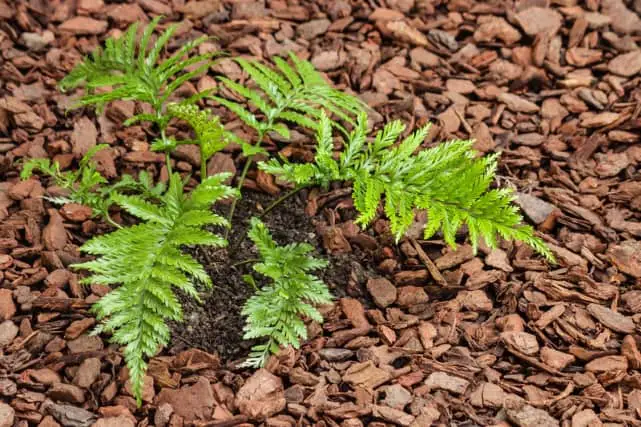
The best materials are leaf litter, pine needles or bark chippings. These will mimic the kind of ground cover that ferns would encounter in a woodland setting, and so suit the needs of the plants ideally.
The benefits of the mulch are to suppress weeds, protect the superficial roots from accidental damage, to trap moisture in the soil by limiting evaporation, and to provide some nutrients in the coming months as the mulch naturally breaks down.
Water regularly for the first year
Finally, an important last step is to water well. Of course, this is best practice for any newly transplanted plant, but for young ferns in particular it is critical.
The first few months after planting are the most vulnerable time for ferns, which are generally moisture-loving plants. So, if rainfall is not sufficient, it is critical to regularly water newly planted ferns throughout the first growing season.
It is also worth noting how sheltered the planting position is, and adjusting your watering plans accordingly. For ferns exposed to winds or sun it is even more essential to ensure they are generously watered in this chancy period before they are fully established and robust.
Although they are flexible plants, there are some times of year that will be more likely to help newly planted ferns thrive. You’ll know you’ve succeeded when the fiddleheads rise triumphantly in the following spring.
